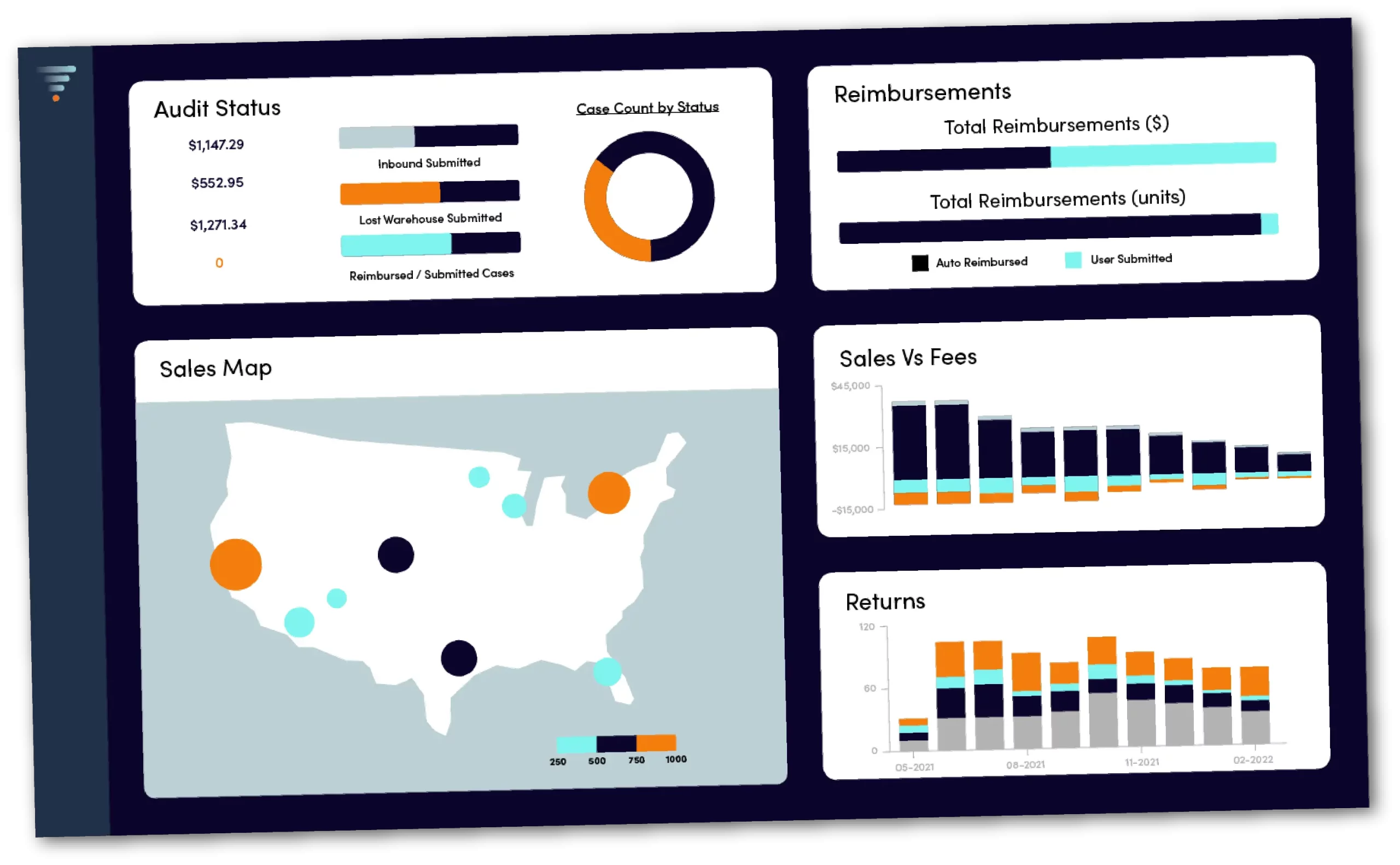Why Tracking Seller Performance on Amazon is Essential
Monitoring Amazon KPIs is critical for sellers to achieve long-term and short-term success on Amazon.
By keeping track of Amazon Seller Performance metrics, you can:
- Gain valuable insights for improving your Amazon business.
- Maintain good account health.
- Monitor your seller account’s adherence to the performance targets and Amazon policy violations.
- Use data to optimize inventory management.
- Boost your conversion rate, product rankings, and traffic.
- Identify issues that might otherwise go unnoticed. For example, responding to customer messages within Amazon’s stipulated 24-hour window.
In this article, we’ll give you a detailed view into tracking seller performance on Amazon and highlight tools for the Amazon marketplace that can help you achieve a competitive advantage.

Get Back the Money You’re Owed from Amazon
How to Track Your Seller Performance on Amazon
As an Amazon FBA seller, monitoring performance is essential to your success. To track your seller performance,
- Log into your Amazon Seller Central account
- On the dashboard, hover over the “Performance” tab at the top
- Click on “Account Health”
This page offers an overview of your seller account’s adherence to Amazon performance targets and policies stipulated to sell on Amazon. Frequently monitoring your seller performance metrics also helps you prevent the risk of account deactivation or suspension.
Performance Metrics Tab
To view your performance metrics, navigate to the Performance metrics tab under the Performance section in your Amazon Seller account.
Tracking the following performance metrics will enable you to measure your sales performance and get insights into how to resolve any issues:
- Order defect rate (ODR): Order defect rate is the percentage of consumers who purchased damaged or poor-quality products within a specified time. It is calculated by dividing the total number of returned and negatively reviewed orders by the total number of orders simultaneously.
- Three main factors contribute to your ODR, namely:
- Negative feedback rate: A one or two-star product review is considered negative feedback and increases your ODR.
- Service chargeback rate: A chargeback happens when customers contact their bank to reverse the transaction and receive a refund, negatively affecting your ODR.
- Filed A-to-Z claim rate: The Amazon A-to-Z guarantee gives the customers full reimbursements for their purchases if something goes wrong such as an unpunctual delivery. Each A-to-Z is a hit to your order defect rate unless Amazon denies it, the customer withdraws the claim, or if Amazon doesn’t hold you responsible for the claim.
- An ODR over 1% in 60 days can lead to Amazon account suspension, meaning a temporary deactivation until the problem is resolved.
- Three main factors contribute to your ODR, namely:
- Cancellation rate (CR): Cancellation rate (or pre-fulfillment cancellation rate) is calculated by dividing the number of seller-canceled orders by the total number of orders during a given 7-day time period.
- You could lose your selling privileges if you have a cancellation rate higher than 2.5%.
- Late shipment rate (LSR): Late shipment rate is the percentage of total orders that were shipped late during a given 7-day period. A late shipment happens when an order is not confirmed by three to four days.
- Amazon has a maximum late shipment rate of 4%. An LSR higher than 4% typically leads to a suspension. If your Amazon account gets suspended, you’ll need to make an account reinstatement appeal and submit a solid action plan.
- Valid tracking rate (VTR): Valid tracking rate is the percentage of total delivered with valid tracking numbers. This information enables customers to track their order status.
- Amazon requires you to maintain a VTR of 95% or higher for all categories.
Customer Feedback Tab
Navigate to the Customer Feedback tab under the Performance section in your Seller account to view the customer feedback you’ve received.
You can use the Feedback Manager to monitor customer satisfaction with your service. It shows short and long-term metrics and detailed feedback entries.
Customer feedback (not to be confused with product reviews and seller feedback) gives a breakdown of feedback ratings and comments from customers over the past 30, 90, and 365 days, and over the lifetime of the business.
Negative reviews are inevitable when you sell on Amazon marketplace or any other eCommerce platform. However, Amazon’s customer feedback system enables you to resolve buyer issues and improve the customer experience. This way, customers remove negative feedback while allowing sellers to learn from their mistakes.
Regularly check your customer feedback as a seller to spot any issues in your Amazon listing description or product quality and remedy them immediately.
Once a customer posts feedback, you have up to 60 days to rectify an adverse reaction. After that, you can use Amazon’s FeedbackFive tool to receive performance notifications whenever any new feedback is received for your ASIN.
Reports Tab
To view your performance reports, navigate to the Reports tab under the Performance section in your Seller account.
The reports section helps you understand the performance of your order fulfillment.
The Orders with Defects report comes with a bar graph that shows orders that were canceled, shipped late, given negative feedback, and received A-to-Z Guarantee claims and chargebacks on credit card purchases over the last 365 days.
The Performance over Time report provides tabular information about order performance over the last 12 months.
What About the Performance Metrics Seller Central Doesn’t Give You?
Understanding the metrics and reports provided within Seller Central certainly helps you optimize your product listings and performance. But that may not be enough in this competitive landscape to stay ahead and truly thrive on Amazon.
Here are a few things that the Performance Metrics Seller Central fails to provide:
- Segmented account health information: Seller Central can pull the aforementioned reports, but it cannot holistically show sellers their total performance health with enough detail to help them do something about it.
- Lack of meaningful customer insights: You get basic data on your audience, so you need to analyze and interpret the numbers to extract any actionable information.
To gain a competitive advantage with your data, you need a platform like Sifted Marketplace Intelligence to fill any Seller Central gaps. Here’s a look at some of the Amazon analytics tools offered by Sifted:
- FBA Fee Analyzer: FBA Fee Analyzer accurately estimates how much it costs you to sell on Amazon. You can get a full breakdown of fees and identify discrepancies to get reimbursements.
- Sales Visualization Heatmap: This visualization tool helps you optimize your fulfillment operations using geographical sales data. Easily view, filter, and search through 18 months of Amazon sales data in one map to make informed decisions about marketing spend and inventory distribution.
- Audit and Recovery: You can use this tool to audit your Amazon data daily to identify money owed to you due to operational errors. With this information, you can either submit a reimbursement claim yourself or get our full-service reimbursement recovery service to secure the money you’re owed from Amazon.
Optimize Your Operations with Sifted Marketplace Intelligence
Tracking Amazon Seller Metrics is the key to improving your Amazon account health and staying in the good books of Amazon. However, with the right tools, you can make better fulfillment decisions, save money, and gain a competitive advantage.
Sifted Marketplace Intelligence offers sellers the tools to optimize their Amazon operations and maximize reimbursements. The all-in-one software has audits for storage, shipment and fulfillment errors, as well as reimbursement recovery. The sales heatmap also gives sellers visibility into their product sales performance geographically.
Ready to recover losses and boost your profits on Amazon? Sign up for Marketplace Intelligence for free!











